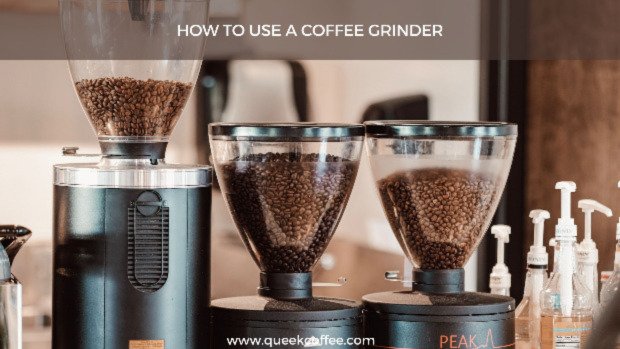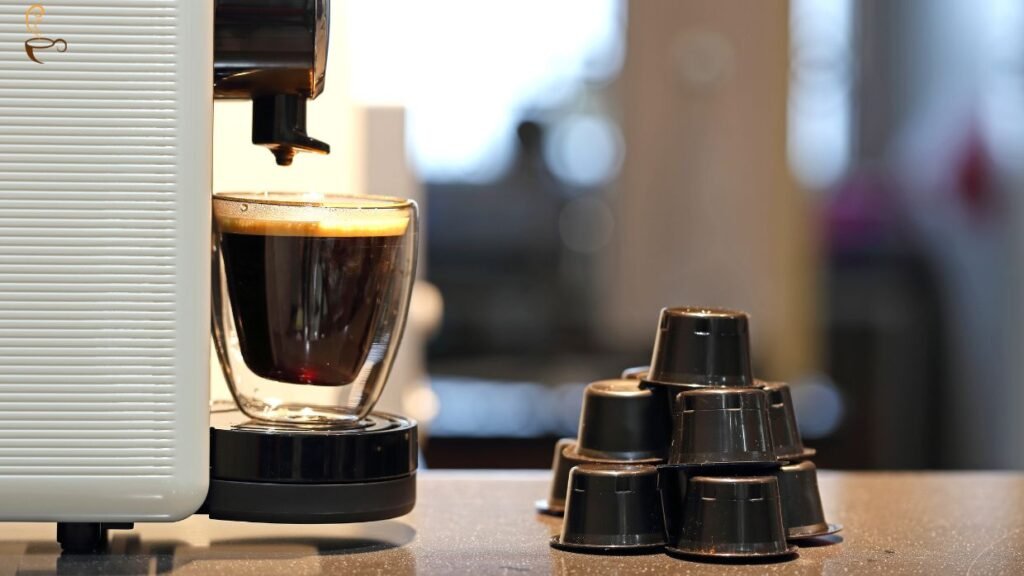If you’re a coffee enthusiast like us, you believe that the perfect cup of coffee is an art form worth mastering. And one essential tool in your caffeinated arsenal is the trusty coffee grinder. Sure, pre-ground coffee can do the job, but grinding your beans fresh is the way to go if you want to elevate your coffee game to a new level.
But how exactly do you use a coffee grinder? Don’t worry; we’ve got you covered! In this step-by-step guide, we’ll walk you through using a coffee grinder like a pro. Prepare to maximize the flavor of your preferred beans, and prepare a cup that will send your taste buds into a state of excitement. Let’s dive in, shall we?
How To Use A Coffee Grinder
Now it’s time to unveil the secrets of using a coffee grinder in the right ways. Let’s dive in.
1. Understanding Your Coffee Grinder

To kickstart our journey into the world of coffee grinding, it’s crucial to understand the inner workings of your coffee grinder. The two most common types of coffee grinders are blade grinders and burr grinders.
Blade grinders, typically more affordable, feature a spinning blade that chops the coffee beans into smaller pieces. On the other hand, burr grinders use two abrasive surfaces, known as burrs, to crush the beans into consistent particle sizes.
While blade grinders can get the job done, burr grinders are widely regarded as the superior option because they produce a more consistent grind, which ultimately translates into a more balanced and flavorful cup of coffee.
Finding a grinder that meets your goals and budget while still being of great quality is crucial. Look for grinders with sturdy construction, adjustable grind settings, and a reputation for producing consistent results.
Familiarize yourself with the various parts of your grinder, such as the hopper, grind size selector, and collection container. Understanding how each component functions will ensure you have greater control over your grinding process. So, let’s get to know our coffee grinders inside out and unleash their full potential in our pursuit of the perfect brew.
2. Choosing the Right Coffee Beans

Choosing the right coffee beans is paramount when achieving an exceptional cup of coffee. The freshness and quality of your coffee, among other crucial factors, can significantly impact its flavor and aroma. Start by opting for beans that have been recently roasted to ensure optimal freshness. Look for a roast date on the packaging and aim for beans that have been roasted within the past two to four weeks.
Also, consider the origin and flavor profile of the beans. Different regions produce coffee with distinct characteristics, such as fruity, chocolatey, nutty, or floral notes. Experiment with beans from various origins to discover your personal preferences. Some popular coffee-growing regions include Ethiopia, Colombia, Brazil, and Costa Rica.
Furthermore, consider whether you prefer single-origin beans or blends. Single-origin beans showcase the unique flavors of a specific region, while blends combine different beans to achieve a desired flavor profile.
Ultimately, it all boils down to your taste preferences. Don’t be afraid to explore and try different beans to find the ones that genuinely excite your palate. Remember, the journey to a great cup of coffee starts with selecting the finest beans to serve as the foundation of your brewing adventure.
How to Choose the Right Coffee Beans
In a nutshell, let’s see how to choose the right coffee beans:
- Look for recently roasted beans with a roast date within the past two to four weeks.
- Consider the origin of the beans and the flavor profile associated with different regions.
- Experiment with beans from various origins to discover your preferred taste preferences.
- Determine if you choose single-origin beans that highlight the unique flavors of a specific area or blends that offer a balanced flavor profile.
- Read reviews and seek recommendations from fellow coffee enthusiasts or trusted sources.
- Consider the brewing method you’ll be using, as some beans may be better suited for certain brewing styles.
- Check for certifications such as Fair Trade, Organic, or Rainforest Alliance, if those factors are important to you.
- Take note of any additional information provided on the packaging, such as processing methods or specific tasting notes.
- Consider the roast level that aligns with your taste preferences, whether light, medium, or dark roast.
- Visit local specialty coffee shops or roasters to explore their selection and ask for guidance from knowledgeable staff.
3. Adjusting Grind Size
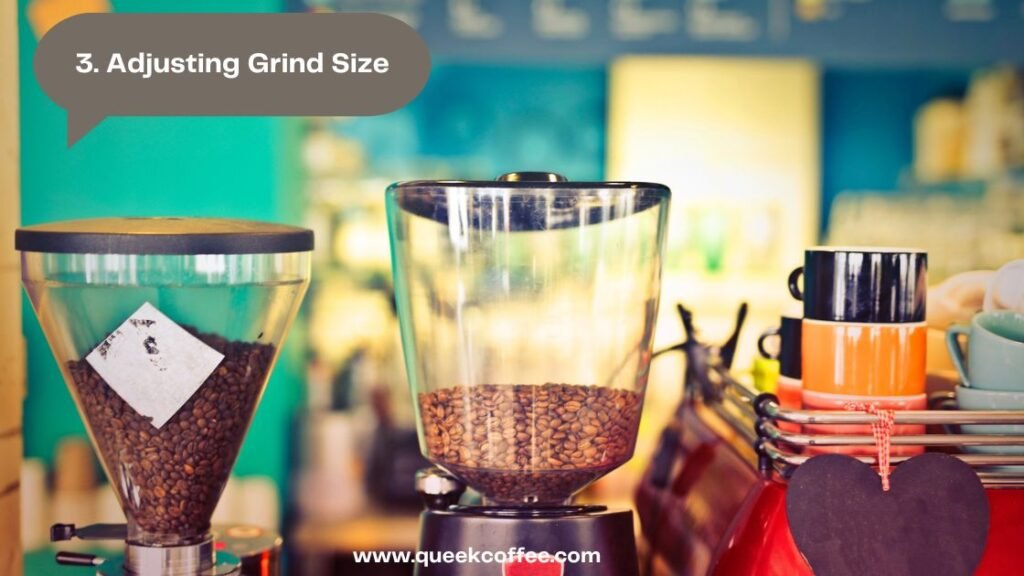
Adjusting the grind size is a crucial step in the coffee brewing process, as it directly affects your cup’s extraction and overall flavor. The grind size refers to the coarseness or fineness of the coffee particles, and it needs to be matched to the brewing method you’re using.
A particular grind size is required for each brewing technique in order to maximize the extraction process. For instance, a coarser grind is optimal for procedures like the French press, where coffee grounds are soaked in water for a long time. On the other hand, a finer grind is necessary for espresso, where water is forced through compacted coffee grounds under high pressure. To adjust the grind size on your specific grinder, consult the user manual or look for adjustable settings on the grinder itself.
Many grinders have a dial or knob that allows you to choose from different grind sizes. Finding the sweet spot for each brewing method is essential to achieve the desired flavor. As a general guideline, coarser grinds are suitable for methods like French press, cold brew, and pour-over, while finer grinds are recommended for espresso, Aeropress, and Moka pots.
However, these are just starting points; you can fine-tune the grind size based on your preferences. Remember, finding the right grind size may require some experimentation and adjustments. Still, once you discover the perfect setting for your preferred brewing method, you’ll unlock a whole new world of flavors and aromas in your coffee.
4. Cleaning and Maintaining Your Grinder

Keeping your coffee grinder clean and properly maintained is essential for ensuring consistent performance and preserving the quality of your coffee. Regular cleaning helps prevent the buildup of coffee residue, oils, and stale particles that can affect the flavor of your brew.
The specific cleaning process will depend on the type of grinder you have. For blade grinders, start by unplugging the grinder and removing the grinding chamber or blade. Use a brush or a cloth to wipe away any coffee grounds or residue from the edge and the interior of the chamber.
Avoid getting water on the electrical components. For burr grinders, you’ll need to disassemble the grinder according to the manufacturer’s instructions. Brush away any coffee particles from the burrs and other removable parts, then wash them with warm water and mild soap.
Make sure to thoroughly dry all the components before reassembling the grinder. It’s recommended to clean your grinder every few weeks or whenever you switch between different types of coffee beans. In addition to regular cleaning, proper maintenance is essential.
Keep an eye on the burrs and replace them when worn or damaged. Some grinders may require periodic calibration to ensure consistent grind sizes. For detailed maintenance instructions for your grinder model, consult the user handbook. By practicing regular cleaning and maintenance, you’ll extend the lifespan of your grinder, maintain the quality of your coffee, and ensure that every cup you brew is a flavorful and enjoyable experience.
Cleaning and Maintaining Tips
Clean your coffee grinder regularly to prevent the buildup of coffee residue, oils, and stale particles. In a nutshell, let’s see how to clean and maintain your coffee grinder:
- Unplug the grinder before cleaning to ensure safety.
- Remove the grinding chamber or blade for blade grinders and wipe away any coffee grounds or residue with a brush or cloth.
- For burr grinders, disassemble the grinder according to the manufacturer’s instructions and brush away coffee particles from the burrs and other removable parts.
- Wash the removable parts of the burr grinder with warm water and mild soap, ensuring they are thoroughly dried before reassembling.
- Clean your grinder every few weeks or whenever you switch between different types of coffee beans.
- Monitor the condition of the burrs and replace them when worn or damaged.
- Some grinders may require occasional calibration to maintain consistent grind sizes.
- Refer to the user manual or manufacturer’s instructions for specific maintenance guidelines for your grinder model.
- Cleaning and maintaining your grinder properly will increase its lifespan, preserve the quality of your coffee, and guarantee dependable and delightful brewing experiences.
5. Grinding for Drip Coffee

Grinding coffee for drip brewing is all about finding the right balance between extraction and flavor. Drip coffee makers typically require a medium grind size between coarse and fine. To extract the good flavors without over- or under-extracting, the grind should allow water to pass through the coffee grounds at a moderate rate. To grind coffee for drip brewing, start by ensuring your grinder is set to the appropriate grind size.
The exact setting may vary depending on your grinder and personal preferences but aim for a medium grind consistent with granulated sugar. Once you have the right grind size, measure the number of whole coffee beans for your desired coffee strength and load them into the grinder’s hopper.
Start the grinding process, allowing the grinder to work magic and transform the beans into evenly sized particles. Once the grinding is complete, you’re ready to brew your drip coffee. Transfer the freshly ground coffee into your coffee maker’s filter basket, ensuring an even distribution of grounds.
Follow the manufacturer’s instructions for water-to-coffee ratios and brewing time. With the right grind size, you should achieve a well-balanced cup of drip coffee with a harmonious blend of flavors and a pleasant aroma. Try various grind sizes and brewing conditions to satisfy your coffee desires. Keep in mind that everyone has distinct taste preferences.
Grinding Tips For Drip Coffee
Let’s see how to grind your coffee beans for Drip Coffee:
- Set your grinder to medium grind size, resembling granulated sugar.
- Aim for a consistent grind size to ensure even extraction during drip brewing.
- Measure the desired amount of coffee beans based on your preferred coffee-to-water ratio.
- Load the beans into the grinder’s hopper and start the grinding process.
- Transfer the grounds to the filter basket of your drip coffee maker.
- Ensure an even distribution of grounds in the filter basket for uniform extraction.
- The required volume of water should be added to the coffee maker’s water reservoir.
- Start the brewing process according to the manufacturer’s instructions.
- Pay attention to the brewing time and adjust the grind size or coffee-to-water ratio to achieve the desired strength and flavor.
- Experiment with different beans, grind sizes, and brewing parameters to find your preferred profile for a delicious cup of drip coffee.
6. Grinding for French Press
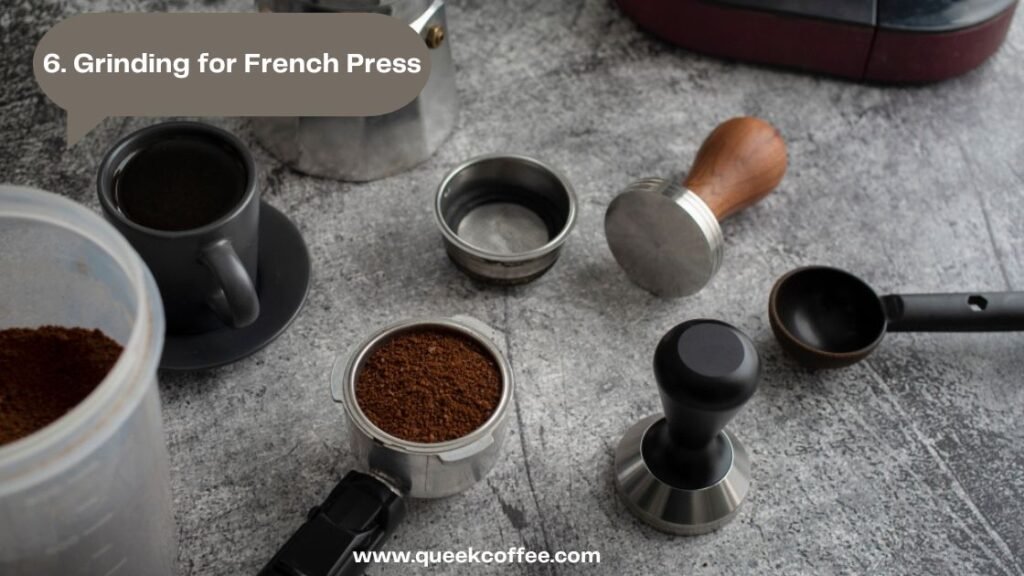
Grinding coffee for French press brewing requires a coarser grind size to accommodate the extended steeping time and the mesh filter of the French press. The coarser grind allows for a slower extraction process and helps avoid over-extraction and sediment in the final cup.
Adjust your grinder to a coarse setting to achieve the perfect grind for your French press. The coffee grounds should resemble coarse sea salt or breadcrumbs. This grind size ensures the water can penetrate the grounds without passing through the mesh filter, resulting in a flavorful and clean cup of coffee. Once you’ve set the grinder to the appropriate setting, measure the desired amount of whole coffee beans based on your preferred coffee-to-water ratio.
Place the beans in the grinder’s hopper and start the grinding process. As the beans are transformed into coarse particles, you’ll notice the distinct aroma of freshly ground coffee filling the air. Once the grinding is complete, carefully transfer the coarse grounds into the French press’s chamber.
Please make sure the grounds are evenly wet, and pour hot water over them. Place the plunger and lid on the French press after gently stirring the coffee to ensure good extraction, and let it steep for however long you like. After the advised steeping period, slowly depress the plunger to separate the brewed coffee from the grounds. Enjoy every rich, aromatic coffee sip after pouring it into your favorite mug.
For French press brewing, a coarse grind size offers a strong and full-bodied cup, highlighting the distinctive flavors and aromas of the coffee beans. You can change the brewing settings and the grind size to suit your taste. This enables you to optimize your French press brewing method and find the ideal balance that satisfies your thirst for coffee.
Grinding Tips For French Press
Let’s see how to grind your coffee beans for French Press:
- Set your grinder to a coarse setting to achieve the ideal grind size for French press brewing.
- Aim for a grind size that resembles coarse sea salt or breadcrumbs.
- Measure the desired amount of whole coffee beans based on your preferred coffee-to-water ratio.
- Place the beans in the grinder’s hopper and start the grinding process.
- Once the grinding is complete, transfer the coarse grounds into the French press’s chamber.
- To ensure the grounds are equally covered, pour hot water over them.
- To encourage proper extraction, give the mixture a little swirl.
- After adding the plunger and lid to the French press, let the coffee soak according to the directions.
- Slowly depress the plunger to separate the brewed coffee from the grounds after the desired steeping time.
- Enjoy your cup of freshly brewed French press coffee by pouring it into it once it has been freshly brewed.
7. Grinding for Espresso
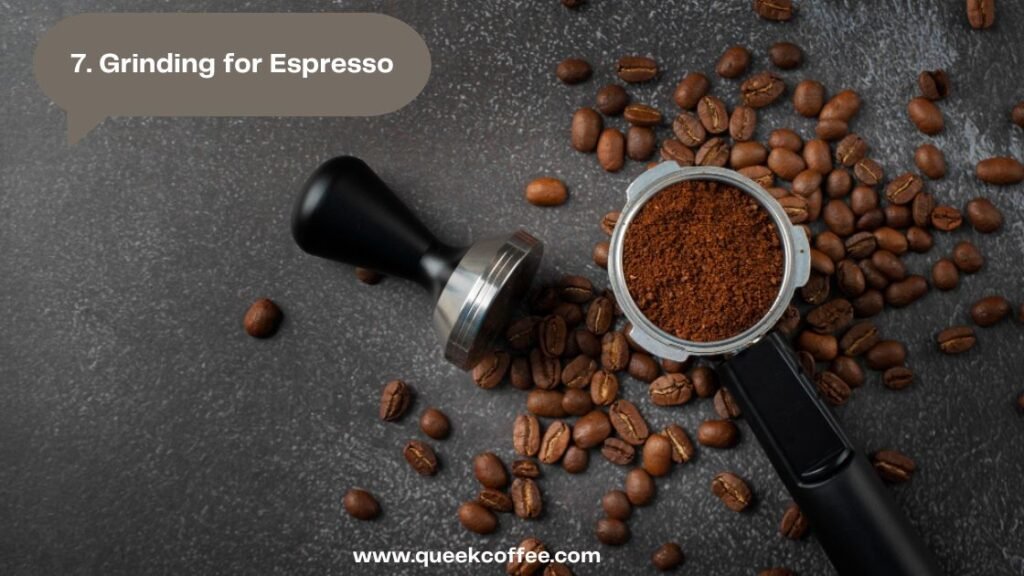
Grinding coffee for espresso is a delicate art that requires precision to achieve the desired extraction and create that rich, flavorful shot of espresso. Espresso calls for an adequate and consistent grind size to maximize the surface area of the coffee grounds and allows for the optimal extraction of oils and flavors quickly.
To grind coffee for espresso, adjust your grinder to a fine setting, similar to the texture of granulated sugar or even finer. The goal is to create a powdery consistency to ensure water passes through the tightly packed coffee puck evenly. Once you have the appropriate grind size, measure the right amount of coffee beans based on the dose required for your espresso shot.
Place the beans in the grinder’s hopper, and as you start the grinding process, you’ll witness the transformation of the beans into a fine powder, releasing the enticing aroma of freshly ground coffee. After grinding, swiftly transfer the grounds to your portafilter, ensuring an even distribution across the basket. Use a tamper to compress the coffee grounds gently and uniformly, creating a level and compact coffee bed.
This step is crucial for achieving consistent extraction and avoiding channeling. Let the brewing process start after locking the portafilter into your espresso maker. Under high pressure, the water will interact with the finely ground coffee, extracting the intense flavors and forming a velvety crema on top. The result is a concentrated and robust shot of espresso, ready to be enjoyed on its own or as the foundation for various espresso-based drinks.
Remember that dialing in the grind size may require experimentation to find the perfect balance that suits your taste preferences and your espresso machine. With practice and attention to detail, you can consistently produce exceptional espresso shots that rival your favorite café.
Grinding Tips For Espresso
Let’s see how to grind your coffee beans for Espresso:
- Adjust your grinder to a fine setting, resembling the texture of granulated sugar or even finer.
- Aim for a consistent and powdery grind size to maximize surface area and ensure even extraction.
- Measure the appropriate amount of coffee beans based on the dose required for your espresso shot.
- Load the beans into the grinder’s hopper and start the grinding process.
- Transfer the finely ground coffee into the portafilter, ensuring an even distribution across the basket.
- Use a tamper to gently and uniformly compress the coffee grounds, creating a level and compact coffee bed.
- Lock the portafilter into your espresso machine, preparing it for brewing.
- Pay attention to the extraction time and adjust to achieve the desired shot length.
- Monitor the appearance of the espresso shot, aiming for a rich and velvety crema on top.
- Experiment with various grind sizes and brewing conditions to achieve the ideal balance that complements your palate preferences and espresso machine.
8. Grinding for Pour Over
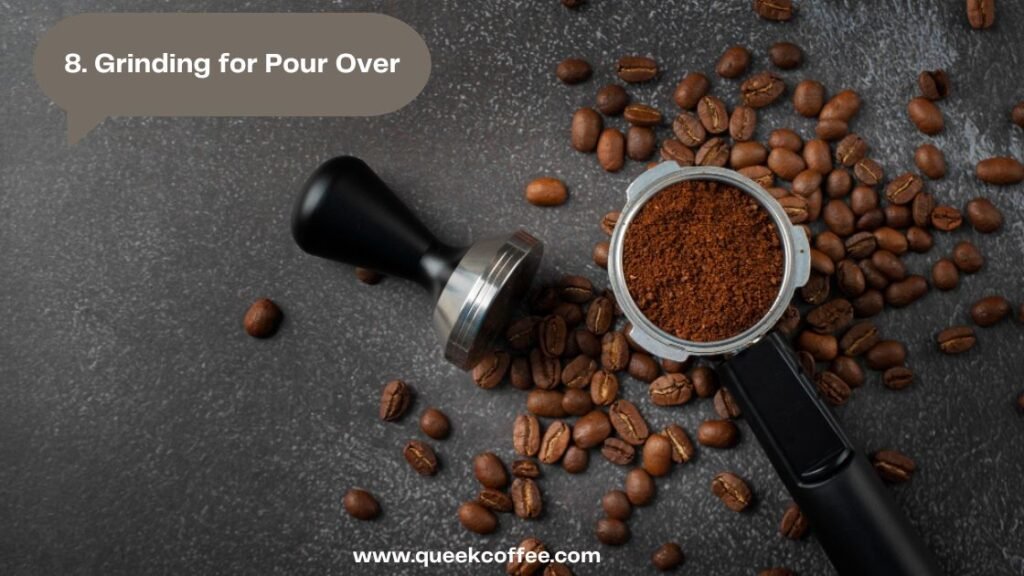
Grinding coffee for pour-over brewing is all about finding the right balance between extraction and clarity. Pour-over methods, such as the V60, Chemex, or Kalita Wave, require a medium to medium-fine grind size that allows for a controlled and even extraction.
The ideal grind size for pour-over should be slightly finer than the grind size used for drip brewing. This finer grind promotes a slower flow of water through the coffee grounds, enhancing the extraction of flavors while maintaining clarity in the cup. To grind coffee for pour-over, adjust your grinder to a medium to medium-fine setting, similar to sand or table salt texture.
The goal is to produce a consistent grind size to produce a consistent extraction. Once you have the right grind size, measure the desired quantity of whole coffee beans based on your chosen coffee-to-water ratio. Place the beans in the grinder’s hopper, turn on the machine, and enjoy the aroma of freshly ground coffee filling the air.
Transfer the ground coffee into your pour-over kettle or filter once the grinding is finished. To ensure that all the coffee grounds are evenly saturated, pour hot water over them in a circular motion, working your way out from the center. Allow the water to flow through the grounds gradually, controlling the flow rate to achieve a balanced extraction.
The result will be a clean and vibrant cup of pour-over coffee, highlighting the coffee beans’ nuanced flavors and delicate aromas. Remember, adjusting the grind size and experimenting with brewing techniques will allow you to fine-tune your pour-over brewing process, helping you discover the perfect balance that satisfies your taste buds and elevates your coffee experience.
Grinding Tips For Pour Over
Let’s see how to grind your coffee beans for Pour Over:
- Adjust your grinder to a medium to medium-fine setting, resembling the texture of sand or table salt.
- Aim for a uniform grind size to ensure an even extraction during pour-over brewing.
- Measure the desired amount of coffee beans based on your preferred coffee-to-water ratio.
- Load the beans into the grinder’s hopper and start the grinding process.
- Transfer the grounds into your pour-over device or filter, ensuring an even distribution.
- Heat water to the appropriate temperature for pour-over brewing (typically between 195°F to 205°F or 90°C to 96°C).
- To moisten the coffee grounds evenly, pour hot water over them in a circular motion, starting in the center and moving outward.
- Control the flow rate of water to achieve a balanced extraction, adjusting as needed.
- Pay attention to the brewing time and change the grind size or pouring technique to complete the desired flavor profile.
- Experiment with different grind sizes, water-to-coffee ratios, and pouring techniques to discover your preferred brewing parameters for pour-over coffee.
9. Grinding for AeroPress
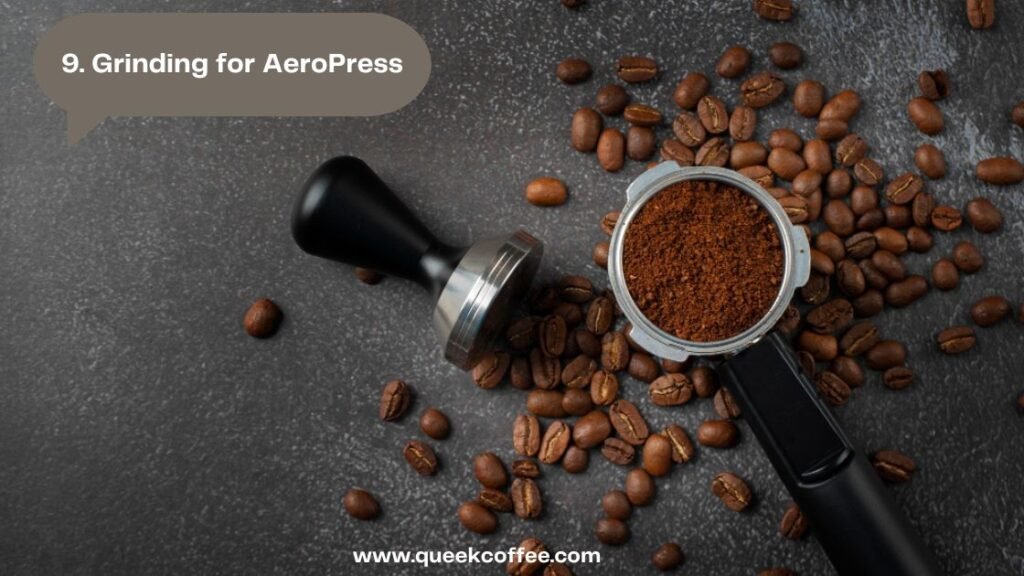
Grinding coffee for AeroPress brewing requires a versatile grind size that allows for flexibility in brewing parameters and extraction preferences. The AeroPress is known for its versatility, producing a wide range of flavors and strengths depending on the grind size and brewing method.
Generally, a medium-fine to fine-grind is recommended for AeroPress brewing. This grind size allows for a relatively short brew while still extracting the desired flavors and aromas. To grind coffee for AeroPress, adjust your grinder to a medium-fine to fine setting, resembling the texture of fine sand or slightly finer.
This grind size will provide optimal extraction and avoid any unwanted bitterness. Once you have the appropriate grind size, measure the desired amount of coffee beans based on your preferred coffee-to-water ratio.
Load the beans into the grinder’s hopper and start the grinding process, witnessing the transformation of the beans into fine particles and inhaling the enticing aroma. After grinding, transfer the grounds into the AeroPress chamber, ensuring an even distribution. With your hot water ready, begin the brewing process.
You can experiment with different brewing methods, such as the standard, inverted, or variations like the “stir and bloom” technique. These methods, coupled with the medium-fine to fine-grind, allow you to control the brewing time and extraction, resulting in a versatile range of flavors and strengths.
Once brewed, gently press the plunger to extract the coffee into your cup. The AeroPress offers a quick and convenient way to brew a flavorful and customizable cup of coffee. Feel free to adjust the grind size and brewing parameters according to your preferences, allowing you to explore and unlock the full potential of the AeroPress brewing method.
Grinding Tips For AeroPress
Let’s see how to grind your coffee beans for AeroPress:
- Adjust your grinder to a medium-fine to fine setting, resembling fine sand or a slightly finer texture.
- Aim for a versatile grind size that allows flexibility in brewing parameters and extraction preferences.
- Measure the desired amount of coffee beans based on your preferred coffee-to-water ratio.
- Load the beans into the grinder’s hopper and start the grinding process.
- Transfer the fine grounds into the AeroPress chamber, ensuring an even distribution.
- Heat water to the appropriate temperature for brewing (typically between 195°F to 205°F or 90°C to 96°C).
- Choose a brewing method, such as the standard method, the inverted method, or variations like the “stir and bloom” technique.
- Pour hot water into the AeroPress chamber, following your chosen brewing method.
- Control the brewing time and extraction by adjusting variables like water-to-coffee ratio and stirring technique.
- Press the plunger gently to extract the brewed coffee into your cup.
- Experiment with different grind sizes, brewing methods, and brewing parameters to discover your preferred flavor profiles and strengths when using AeroPress.
10. Experimenting and Fine-tuning
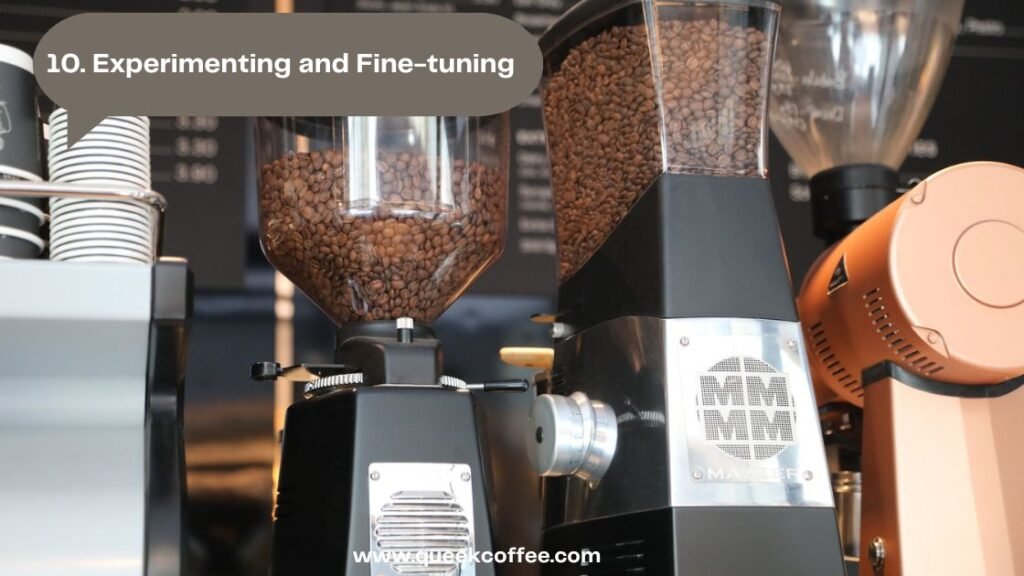
You may uncover your tastes and maximize the potential of your coffee beans by experimenting and perfecting your coffee grinding process. The genuine fun of brewing coffee resides in the ability to modify and alter the process to suit your taste buds, even while general rules might serve as a starting point.
You can explore the nuances of different grind sizes, brewing methods, water-to-coffee ratios, and brewing times through experimentation. Adjusting these variables allows you to create a cup of coffee that perfectly matches your desired strength, flavor profile, and aroma.
Take the time to explore various grind sizes, ranging from coarse to fine, and observe how they affect the taste and extraction. Consider adjusting the water-to-coffee ratio to find the balance that suits your preferences—stronger or milder. Don’t be afraid to try different brewing methods, such as pour-over, AeroPress, French press, or espresso, and discover the unique characteristics of your coffee. Keep a record of your experiments, noting the grind size, brewing parameters, and tasting observations.
This will help you refine your techniques and replicate your favorite brews in the future. Remember that taste is subjective, and what suits one person may not suit another. Embrace the process of experimentation, trust your palate, and allow yourself to indulge in the endless possibilities that come with grinding your coffee beans.
The art of coffee brewing is an ongoing adventure. With each cup, you’ll become more skilled at fine-tuning the variables to create a truly exceptional coffee experience that always delights your senses.
Final Words
Mastering a coffee grinder is essential for any coffee enthusiast seeking to elevate their brewing experience. By understanding your coffee grinder, choosing the right beans, adjusting the grind size, and maintaining its cleanliness, you can unlock the full potential of your coffee beans and extract the flavors and aromas that make each cup a delight.
Whether you’re grinding for drip coffee, French press, espresso, pour-over, or AeroPress, each brewing method requires careful consideration of the grind size to achieve the desired extraction. Experimenting and fine-tuning your techniques allow you to personalize your coffee brewing, creating a cup that perfectly suits your taste preferences.
So, grab your coffee grinder, explore the possibilities, and embark on a flavorful journey as you discover the joy of grinding your coffee beans and savoring the rich and aromatic results in every sip. Cheers to your brewing adventures!
Most Common FAQs
How long should I grind coffee beans for drip brewing?
The ideal grind time for drip brewing can vary depending on the type of grinder you’re using. Generally, it takes 10-15 seconds to grind to achieve a medium grind size resembling granulated sugar. However, it’s recommended to grind in short bursts and check the consistency periodically to avoid over-grinding.
Can I use the same grind size for different brewing methods?
While some grind sizes can be versatile across brewing methods, adjusting the grind size based on your specific brewing method is generally recommended. Each brewing method requires a different grind size to optimize extraction and flavor. Experiment with different grind sizes to achieve the best results for each brewing method.
How do I know if I’ve ground the coffee beans too fine?
If your coffee tastes excessively bitter or over-extracted, it’s likely that the grind size is too fine. Finer grind sizes increase the surface area of the coffee particles, resulting in faster extraction and potential bitterness. To remedy this, adjust your grinder to a slightly coarser setting and try again.
Why does grind size matter in coffee brewing?
Grind size plays a crucial role in coffee brewing because it determines the surface area exposed to water during extraction. Finer grind sizes extract more quickly, resulting in stronger flavors, while coarser grind sizes extract more slowly, leading to milder flavors. Finding the right grind size for your preferred brewing method allows you to control the extraction process and achieve a well-balanced and flavorful cup of coffee.
How often should I clean my coffee grinder?
It’s recommended to clean your coffee grinder regularly to ensure optimal performance and avoid any buildup of oils or coffee residue. Depending on the frequency of use, a general guideline is to clean your grinder thoroughly every two to four weeks. However, you can also clean it more frequently if you notice any changes in taste or aroma.

Zakir Hossain is the accountant of Dan Foods Limited (Dan Cake BD). He loves his family, and whenever he gets an opportunity to spend leisure time, he utilizes it by brewing coffee and enjoying it with his family. He has a beautiful baby girl name Sara Zakir.


